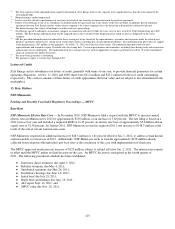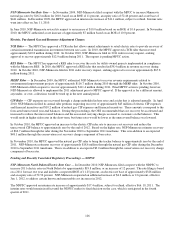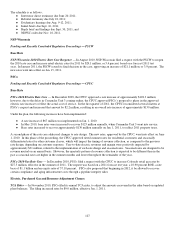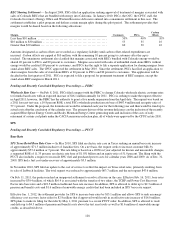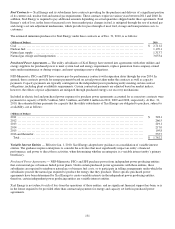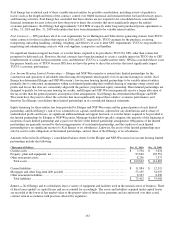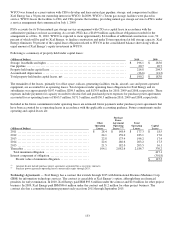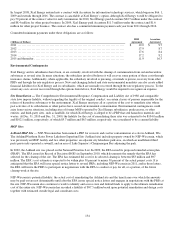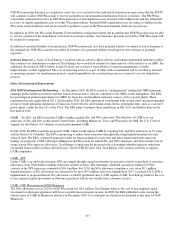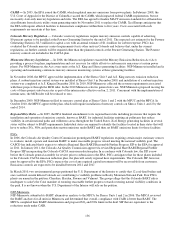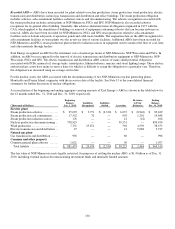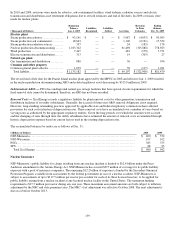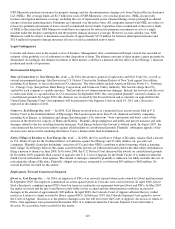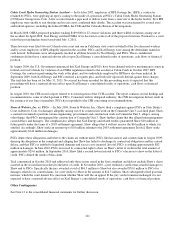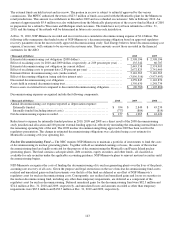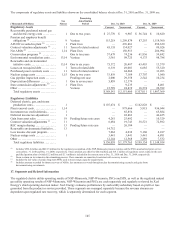Xcel Energy 2010 Annual Report Download - page 145
Download and view the complete annual report
Please find page 145 of the 2010 Xcel Energy annual report below. You can navigate through the pages in the report by either clicking on the pages listed below, or by using the keyword search tool below to find specific information within the annual report.
135
NSP-Wisconsin has deferred, as a regulatory asset, the costs accrued for the Ashland site based on an expectation that the PSCW
will continue to allow NSP-Wisconsin to recover payments for environmental remediation from its customers. The PSCW has
consistently authorized recovery in NSP-Wisconsin rates of all remediation costs incurred at the Ashland site and has authorized
recovery of similar remediation costs for other Wisconsin utilities. External MGP remediation costs are subject to deferral in the
Wisconsin retail jurisdiction and are reviewed for prudence as part of the Wisconsin biennial retail rate case process.
In addition, in 2003, the Wisconsin Supreme Court rendered a ruling that reopens the possibility that NSP-Wisconsin may be able
to recover a portion of the remediation costs from its insurance carriers. Any insurance proceeds received by NSP-Wisconsin will
be credited to ratepayers.
In addition to potential liability for remediation, NSP-Wisconsin may also have potential liability for natural resource damages at
the Ashland site. NSP-Wisconsin has recorded an estimate of its potential liability based upon its best estimate of potential
exposure.
Asbestos Removal — Some of Xcel Energy’s facilities contain asbestos. Most asbestos will remain undisturbed until the facilities
that contain it are demolished or removed. Xcel Energy has recorded an estimate for final removal of the asbestos as an ARO. See
additional discussion of AROs below. It may be necessary to remove some asbestos to perform maintenance or make
improvements to other equipment. The cost of removing asbestos as part of other work is immaterial and is recorded as incurred
as operating expenses for maintenance projects, capital expenditures for construction projects or removal costs for demolition
projects.
Other Environmental Requirements
EPA GHG Endangerment Rulemaking — In December 2009, the EPA issued its “endangerment” finding that GHG emissions
endanger public health and welfare and that emissions from motor vehicles contribute to the GHGs in the atmosphere. The EPA
has promulgated permit requirements for GHGs for large new and modified stationary sources, such as power plants. These
regulations became applicable in 2011. In December 2010, the EPA announced a settlement with several states and environmental
groups to begin preparing regulations of emissions from both new and existing steam electric generating units, such as coal-fired
power plants, under Section 111 of the CAA. The EPA plans to propose these regulations in July 2011 and finalize them in the
first half of 2012.
CAIR — In 2005, the EPA issued the CAIR to further regulate SO2 and NOx emissions. The objective of CAIR is to cap
emissions of SO2 and NOx in the eastern United States, including Minnesota, Texas and Wisconsin. In 2008, the U.S. Court of
Appeals for the District of Columbia vacated and remanded CAIR.
In July 2010, the EPA issued the proposed CATR, which would replace CAIR by requiring SO2 and NOx reductions in 31 states
and the District of Columbia. The EPA is proposing to reduce these emissions through federal implementation plans for each
affected state. The EPA’s preferred approach would set emission limits for each state and allow limited interstate emissions
trading. As proposed, CATR will impact Minnesota and Wisconsin for annual SO2 and NOx emissions, and Texas in the form of
ozone season NOx emission allowances. Xcel Energy is analyzing the proposed rule to determine whether emission reductions
are needed from facilities in these affected states. Until CATR becomes final, Xcel Energy will continue activities to support
CAIR compliance.
CAIR – SPS
Under CAIR’s cap and trade structure, SPS can comply through capital investments in emission controls or purchase of emission
allowances from other utilities making reductions on their systems. The remaining scheduled capital investments for NOx
controls in the SPS region are estimated at $16.4 million. For 2010, the NOx allowance compliance costs were $0.5 million.
Annual purchases of SO2 allowances are estimated to be up to $4.5 million each year, beginning in 2013, for phase I. If CATR is
implemented as proposed then no SO2 allowances would be purchased since CATR replaces CAIR. Xcel Energy believes the cost
of any required capital investment or allowance purchases will be recoverable from customers in rates.
CAIR – NSP-Wisconsin and NSP-Minnesota
The NOx allowance cost in 2010 for NSP-Wisconsin was $0.1 million. Xcel Energy believes the cost of any required capital
investment or allowance purchases will be recoverable from customers in rates. In 2009, the EPA published a rule staying the
effectiveness of CAIR in Minnesota effective in December 2009. Cost estimates are therefore not included at this time for NSP-
Minnesota.


